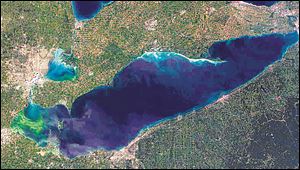
West Lake Erie again fighting bloom of algae
Phosphorus runoff, stagnant air among summer headache’s causes
8/7/2011
This satellite photo shows an algae bloom, in green coloration at left, that continues to grow eastward over a section of Lake Erie.
One of the greatest summertime headaches for western Lake Erie boaters and municipal water-treatment operators is back in full force.
A huge bloom of potentially toxic microcystis algae, which has reared its ugly head almost annually since 1995 after more than a 20-year absence, has been visible from space since at least July 22.
European Space Agency satellite photos given to the National Oceanic and Atmospheric Administration’s Great Lakes Environmental Research Laboratory in Ann Arbor show how it formed in the Monroe area, grew, and has fanned out to the Lake Erie islands.
The images can be seen by going to coastwatch.glerl.noaa.gov.
“This one looks extremely large,” said George Leshkevich, manager of the NOAA lab’s CoastWatch program, which compiles such information for the public. “It’s been a number of days now. It still looks pretty strong.”
A Lake Erie Harmful Algal Bloom Bulletin issued by NOAA on July 28 said the microcystis concentration has been greater than 1,000 micrograms per liter — 500 times greater than the World Health Organization’s standard of 20 micrograms per liter for recreational water.
The values are often expressed in parts per billion. Micrograms per liter and parts per billion convert to identical concentration measurements.
Not all microcystis contains the deadly toxin microcystin. It is not known how much, if any, of the current bloom has that toxin.
“In any case, this stuff is pretty bad for water intakes, even if it’s just taste and odor problems in the best-case scenario,” Mr. Leshkevich said.
Water-treatment plants such as the one that serves a number of communities in metro Toledo are on high alert for such pollutants. They adjust their water chemistry appropriately at the first sign of trouble.
The algae, though, wouldn’t be there if not for the region’s ongoing battle with controlling both storm water and agricultural runoff. It is likely to be a topic of discussion when President Obama’s chief adviser on Great Lakes issues, Cameron Davis, visits the University of Toledo’s Lake Erie Center in Oregon tomorrow with U.S. Rep. Marcy Kaptur (D., Toledo) and UT President Dr. Lloyd Jacobs, according to an aide for Miss Kaptur.
Mr. Davis is to unveil the latest round of Great Lakes Restoration Initiative grants, a program that has brought the Great Lakes region a historic amount of new money to combat pollution. Although its anticipated funding of about $300 million is down significantly from its first-year allocation of $475 million, the program is in response to Mr. Obama’s 2008 campaign pledge to infuse the Great Lakes region with at least $5 billion for cleanup during his administration. More than $20 billion worth of needs, mostly sewage spills that helped algae grow, have been identified.
The lakes always have small, natural concentrations of algae. But heavy spring rain and near-record phosphorus runoff from farms and sewage networks, combined with dry, intense heat and stagnant air of recent weeks, are the likely driving forces behind the bloom.
“Everything that is good for an algae bloom is happening,” David Leffler, Toledo commissioner of operations for the city’s water-treatment and sewage plants, said.
Algae is costly: Besides hurting property values, making boaters miserable, and driving away tourists, it drives up the cost of water treatment.
Gail Hesse, an Ohio Environmental Protection Agency manager and an administrator of the agency’s Lake Erie and surface drinking-water protection programs, told the Ohio Lake Erie Commission last spring that Toledo spends an average of $3,000 to $4,000 a day more on carbon-activated filtration during a bloom.
Mr. Leffler said that’s only one tool in the city’s arsenal.
The city treats water near its water-intake crib with an oxidizing agent, potassium permanganate. The crib juts three miles into Lake Erie, off the Oregon shoreline.
“The more you treat, the more chemicals you use,” Mr. Leffler said. “Sure. When you have to increase the dose, it’s going to be more expensive.”
The microcystis concentration in raw water near the intake crib was 2.26 parts per billion — well within the standard for recreational water but above the 1 ppb standard for drinking water.
After being neutralized by the water-treatment plant, though, the finished tap water was below the nondetectable level of 0.15 ppb, meaning it was safe to drink.
Plant operators have kept the levels within safe drinking levels since, Mr. Leffler said.
Contact Tom Henry at: thenry@theblade.com or 419-724-6079.